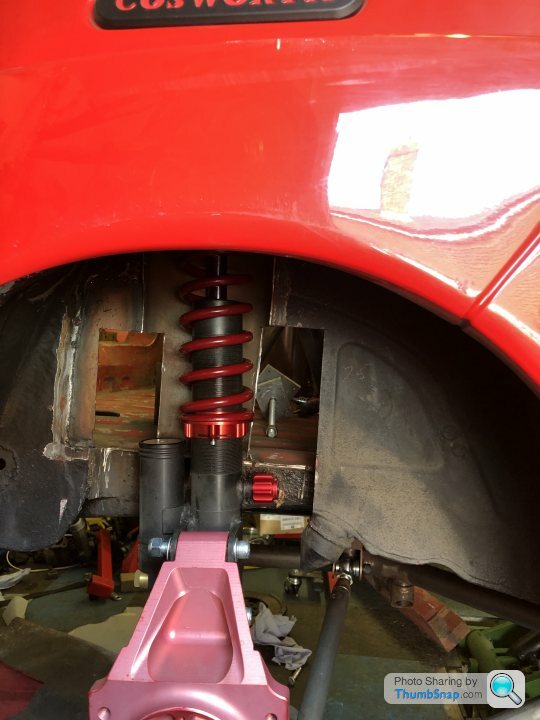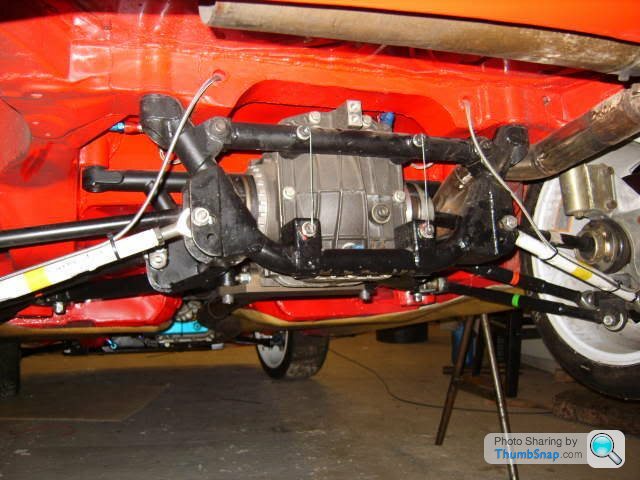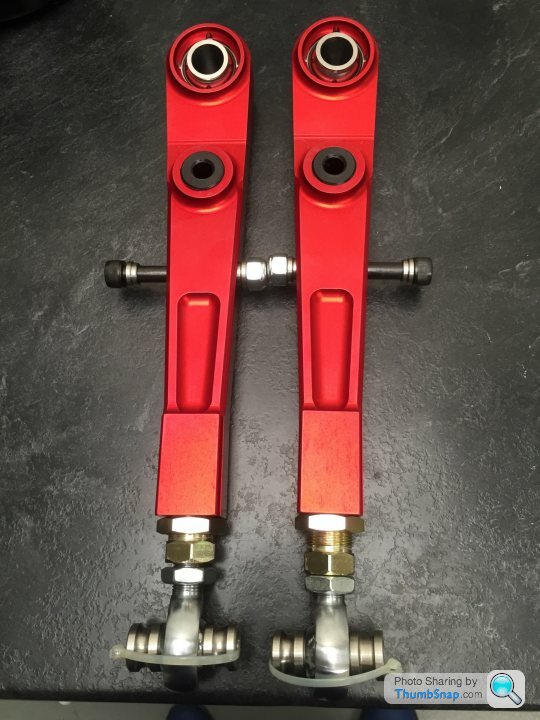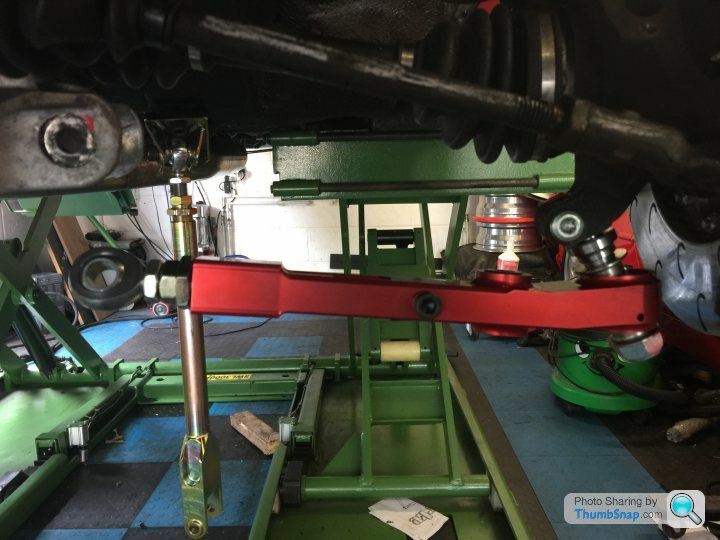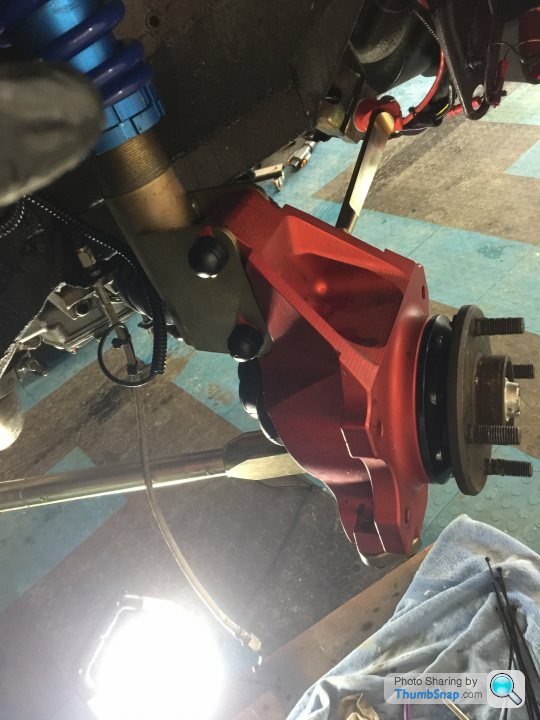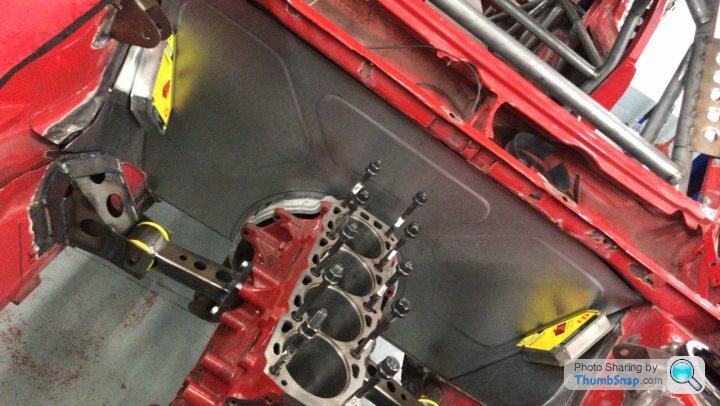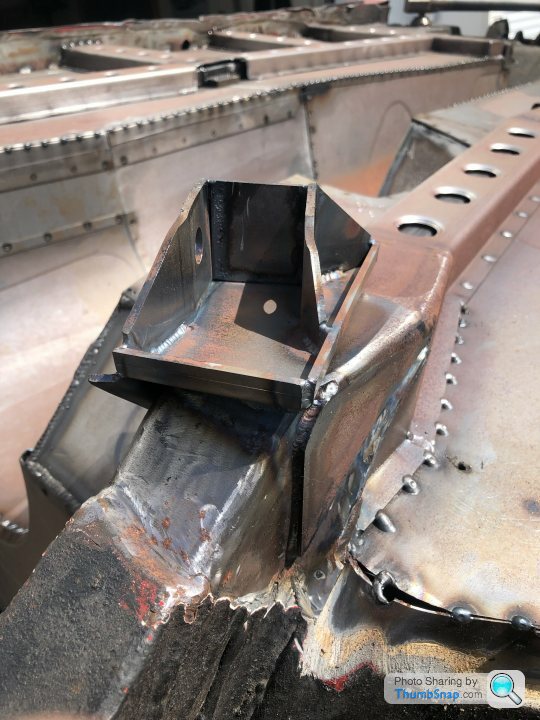Rear suspension castor angle
Discussion
I wouldn't worry too much about it.
Castor on the rear is largely theoretical because the axle doesn't steer (usually). It only really comes into play when you have compliant bushes in the system, where the wheel end geometry (along with the bush stiffnesses) will have a big influence on the magnitude and direction of lateral and longitudinal force steers. It's hard to see the exact suspension layout you're using, but it looks like you're using rose joints, so any compliance effects should be small. (although not zero, the deflection of the links can contribute more than you might think.)
I'd concentrate on making sure your bump steer is not excessively non linear, this might be one negative effect of having some angle on the strut, but it's hard to say just from looking at a photo of course.
Edit to add:
Being a strut, the angle will also influence Anti-squat, but that also depends on the lower arm geometry which can't be seen, and also the 'theoretical' steer axis, which would be difficult to determine without some more detailed analysis.
Castor on the rear is largely theoretical because the axle doesn't steer (usually). It only really comes into play when you have compliant bushes in the system, where the wheel end geometry (along with the bush stiffnesses) will have a big influence on the magnitude and direction of lateral and longitudinal force steers. It's hard to see the exact suspension layout you're using, but it looks like you're using rose joints, so any compliance effects should be small. (although not zero, the deflection of the links can contribute more than you might think.)
I'd concentrate on making sure your bump steer is not excessively non linear, this might be one negative effect of having some angle on the strut, but it's hard to say just from looking at a photo of course.
Edit to add:
Being a strut, the angle will also influence Anti-squat, but that also depends on the lower arm geometry which can't be seen, and also the 'theoretical' steer axis, which would be difficult to determine without some more detailed analysis.
Edited by JoeMk1 on Saturday 23 April 15:32
Edited by JoeMk1 on Saturday 23 April 15:40
Thank you, yes it has got rose joint. It is a close copy of the Ford WRC Cossie cradle. I know they do have some bump steer but I will get gravity force to dial it in as best as they can. I was just worried that something was way out…you have put my mind at rest…..many thanks.
I have already got it more upright.
I have already got it more upright.
It does do ‘something’ but as Joe says I wouldn’t worry too much about it
Only thing I would add is that even without bushes it probably does influence the behaviour of the contact patch because it is ultimately creating loads in different directions
You can feel the difference in changes but it is subtle, and it’s not so much a balance change but a change in progressiveness.
Only thing I would add is that even without bushes it probably does influence the behaviour of the contact patch because it is ultimately creating loads in different directions
You can feel the difference in changes but it is subtle, and it’s not so much a balance change but a change in progressiveness.
The Wookie said:
It does do ‘something’ but as Joe says I wouldn’t worry too much about it
Only thing I would add is that even without bushes it probably does influence the behaviour of the contact patch because it is ultimately creating loads in different directions
You can feel the difference in changes but it is subtle, and it’s not so much a balance change but a change in progressiveness.
Thanks, I will dial out as much as I can with the wheel as central as possibleOnly thing I would add is that even without bushes it probably does influence the behaviour of the contact patch because it is ultimately creating loads in different directions
You can feel the difference in changes but it is subtle, and it’s not so much a balance change but a change in progressiveness.
The Wookie said:
It does do ‘something’ but as Joe says I wouldn’t worry too much about it
Only thing I would add is that even without bushes it probably does influence the behaviour of the contact patch because it is ultimately creating loads in different directions
You can feel the difference in changes but it is subtle, and it’s not so much a balance change but a change in progressiveness.
I did wonder about this, particularly under traction. Would you get the same interaction between mechanical trail and pneumatic trail like on a FWD? I.e if you didn't have a lot of mechanical trail, would you end up transitioning from a castor trail to lead situation under traction? I think you probably would, maybe this is the change in progressiveness you feel?Only thing I would add is that even without bushes it probably does influence the behaviour of the contact patch because it is ultimately creating loads in different directions
You can feel the difference in changes but it is subtle, and it’s not so much a balance change but a change in progressiveness.
Worth adding that we don't actually know the caster angle of this suspension just by looking, it will be unlikely to be along the line of the strut as you presumably have more than one joint at the bottom. Therefore identifying the steering axis is not trivial. Impreza rear suspension as an example, the line of the strut does not define the steering axis:
Edited by JoeMk1 on Sunday 24th April 09:55
JoeMk1 said:
The Wookie said:
It does do ‘something’ but as Joe says I wouldn’t worry too much about it
Only thing I would add is that even without bushes it probably does influence the behaviour of the contact patch because it is ultimately creating loads in different directions
You can feel the difference in changes but it is subtle, and it’s not so much a balance change but a change in progressiveness.
I did wonder about this, particularly under traction. Would you get the same interaction between mechanical trail and pneumatic trail like on a FWD? I.e if you didn't have a lot of mechanical trail, would you end up transitioning from a castor trail to lead situation under traction? I think you probably would, maybe this is the change in progressiveness you feel?Only thing I would add is that even without bushes it probably does influence the behaviour of the contact patch because it is ultimately creating loads in different directions
You can feel the difference in changes but it is subtle, and it’s not so much a balance change but a change in progressiveness.
Worth adding that we don't actually know the caster angle of this suspension just by looking, it will be unlikely to be along the line of the strut as you presumably have more than one joint at the bottom. Therefore identifying the steering axis is not trivial. Impreza rear suspension as an example, the line of the strut does not define the steering axis:
Edited by JoeMk1 on Sunday 24th April 09:55
I’ll be honest though we never really bothered to get our heads round it properly as it’s not really powerful, just a minor feel change that ends up being a bit of a passenger to other more powerful changes that affect it just out of practicality/adjustability
Yes there might be a bit of migration further into trail under braking but the rears do so little (they are literally off the ground at the start of some braking zones) that I doubt that aspect would be noticeable
You make a good point on a RWD car though, I would be very interested to understand the effect on feel under acceleration. I’d assume that it would only have significant effect in the lower gears where it might disappear behind power delivery characteristics for powering out of corners if you see what I mean, but perhaps it might give squirrely sensation in a straight line as it climbs up on the tyre?
The Wookie said:
Actually my experience of having any sort of serious play with it is on an FWD racing car and the progressiveness I’m talking about is just in the way the rear end breaks away laterally.
I’ll be honest though we never really bothered to get our heads round it properly as it’s not really powerful, just a minor feel change that ends up being a bit of a passenger to other more powerful changes that affect it just out of practicality/adjustability
Yes there might be a bit of migration further into trail under braking but the rears do so little (they are literally off the ground at the start of some braking zones) that I doubt that aspect would be noticeable
You make a good point on a RWD car though, I would be very interested to understand the effect on feel under acceleration. I’d assume that it would only have significant effect in the lower gears where it might disappear behind power delivery characteristics for powering out of corners if you see what I mean, but perhaps it might give squirrely sensation in a straight line as it climbs up on the tyre?
Fair point on it being on an FWD car, that puts any traction effects to bed pretty comprehensively haha!I’ll be honest though we never really bothered to get our heads round it properly as it’s not really powerful, just a minor feel change that ends up being a bit of a passenger to other more powerful changes that affect it just out of practicality/adjustability
Yes there might be a bit of migration further into trail under braking but the rears do so little (they are literally off the ground at the start of some braking zones) that I doubt that aspect would be noticeable
You make a good point on a RWD car though, I would be very interested to understand the effect on feel under acceleration. I’d assume that it would only have significant effect in the lower gears where it might disappear behind power delivery characteristics for powering out of corners if you see what I mean, but perhaps it might give squirrely sensation in a straight line as it climbs up on the tyre?
I suppose there's numerous possibilities as to why it would affect lateral progressiveness, even on a fully jointed race car suspension, and it's hard to guess which would be more significant.
Compliance Steer -> body, subframe, link, knuckle, wheel, wheel bearing stiffness etc.
Bump steer (linearity in particular)
Roll centre height & migrations
Camber gain/stiffness
Spring/damper ratio -> Wheel rate linearity
And plenty more I'm sure.
'We've' been doing a lot of advanced modelling lately to analyse the instant centres of a (road car) suspension under different conditions/events, and all I'll say is that is not often where you'd expect based on the 'traditional' kinematic construction.
Ours is very stiff locally and pretty adjustable, but obviously can't completely rule out some minor compliance somewhere having an effect.
As it was pretty like for like with the rest of the geometry we assumed it was something obscure about the contact patch behaviour (after all the force to load everything ultimately starts from there and if the loads are different it stands to reason the contact patch must be doing something different, even if it's slight), but like you say just as likely to be other minor differences adding up
I'd say the best way to find out would be with an SKCMS rig but at that levels it's probably a choice between simulation errors and measurement errors, perhaps better to have the theories in your head and judge the result with a well calibrated Mk1 Arse
As it was pretty like for like with the rest of the geometry we assumed it was something obscure about the contact patch behaviour (after all the force to load everything ultimately starts from there and if the loads are different it stands to reason the contact patch must be doing something different, even if it's slight), but like you say just as likely to be other minor differences adding up
I'd say the best way to find out would be with an SKCMS rig but at that levels it's probably a choice between simulation errors and measurement errors, perhaps better to have the theories in your head and judge the result with a well calibrated Mk1 Arse

I have another query seeing as you were all so helpful:
I have to position the front compression struts. Is there a "best" place for them as it seems to me that we want to reduce the arc as that could pull or push the wheel in the wheel arch (shorten or lengthen the wheel base.
Should it be at 90 degrees to the control arm where it mounts to the chassis?
I have to position the front compression struts. Is there a "best" place for them as it seems to me that we want to reduce the arc as that could pull or push the wheel in the wheel arch (shorten or lengthen the wheel base.
Should it be at 90 degrees to the control arm where it mounts to the chassis?
Caddyshack said:
I have another query seeing as you were all so helpful:
I have to position the front compression struts. Is there a "best" place for them as it seems to me that we want to reduce the arc as that could pull or push the wheel in the wheel arch (shorten or lengthen the wheel base.
Should it be at 90 degrees to the control arm where it mounts to the chassis?
If you were happy with it before then I'd seek to put it as close as possible to the same spot (or at least have it at the same angle as viewed from the side), but you are affecting anti-dive geometry by moving it up and down. The relevant angle is the angle of the compression strut viewed from the side of the car facing the wheel, and I think the relevant bit for the angle to compare against on a MacPherson is effectively to the angle of the strut.I have to position the front compression struts. Is there a "best" place for them as it seems to me that we want to reduce the arc as that could pull or push the wheel in the wheel arch (shorten or lengthen the wheel base.
Should it be at 90 degrees to the control arm where it mounts to the chassis?
I might suggest having a couple of different setting holes, perhaps one higher and one lower, to try out. By increasing the anti-dive (by my guess from your photos raising the inboard compression strut joint) you'll reduce the amount the car pitches under braking although it usually hurts your ability to feel the wheels locking under braking.
I wouldn't worry too much about track change with that length of strut and that low an angle.
Make sure to do this sort of stuff very accurately, particularly so it matches on both sides of the axle, as if you get it wrong even by a couple of mm the car will drive like a bag of crap!
ETA might be obvious but also make sure that wherever you are locating it that it is boxed and that there is a lot of strength and stiffness in the local area as it is a very important and high load joint. If you put it on a flat panel it'll try and punch through it as soon as you go over a pothole or hit a kerb on track!
If I were you I'd have a bit of a read up on vehicle kinematics and geometry (roll-centres/anti-dive) before you start welding stuff in custom positions though, it's all useful to understand anyway but it will give you some perspective on what's at stake getting it right!
Edited by The Wookie on Thursday 28th April 17:07
The Wookie said:
Caddyshack said:
I have another query seeing as you were all so helpful:
I have to position the front compression struts. Is there a "best" place for them as it seems to me that we want to reduce the arc as that could pull or push the wheel in the wheel arch (shorten or lengthen the wheel base.
Should it be at 90 degrees to the control arm where it mounts to the chassis?
If you were happy with it before then I'd seek to put it as close as possible to the same spot (or at least have it at the same angle as viewed from the side), but you are affecting anti-dive geometry by moving it up and down. The relevant angle is the angle of the compression strut viewed from the side of the car facing the wheel, and I think the relevant bit for the angle to compare against on a MacPherson is effectively to the angle of the strut.I have to position the front compression struts. Is there a "best" place for them as it seems to me that we want to reduce the arc as that could pull or push the wheel in the wheel arch (shorten or lengthen the wheel base.
Should it be at 90 degrees to the control arm where it mounts to the chassis?
I might suggest having a couple of different setting holes, perhaps one higher and one lower, to try out. By increasing the anti-dive (by my guess from your photos raising the inboard compression strut joint) you'll reduce the amount the car pitches under braking although it usually hurts your ability to feel the wheels locking under braking.
I wouldn't worry too much about track change with that length of strut and that low an angle.
Make sure to do this sort of stuff very accurately, particularly so it matches on both sides of the axle, as if you get it wrong even by a couple of mm the car will drive like a bag of crap!
ETA might be obvious but also make sure that wherever you are locating it that it is boxed and that there is a lot of strength and stiffness in the local area as it is a very important and high load joint. If you put it on a flat panel it'll try and punch through it as soon as you go over a pothole or hit a kerb on track!
If I were you I'd have a bit of a read up on vehicle kinematics and geometry (roll-centres/anti-dive) before you start welding stuff in custom positions though, it's all useful to understand anyway but it will give you some perspective on what's at stake getting it right!
Edited by The Wookie on Thursday 28th April 17:07
There is a lot of adjustment in the length of the struts so I mainly need to get the exact location of the mount right.
Gassing Station | General Motorsport | Top of Page | What's New | My Stuff




